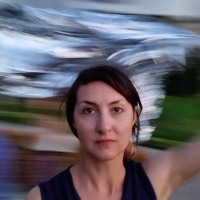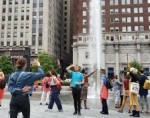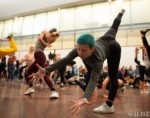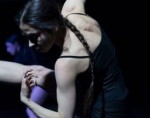
Dance in Europe – in search of artistic and organizational sustainability
by Zornitsa Stoyanova
Spring Forward Festival
After 16 years of living in the U.S., I returned to my hometown of Sofia, Bulgaria, for dance—something I’d never thought I’d do. Spring Forward festival, a competition-style dance festival was happening, and I had to see it. When I hear the word “competition” in the U.S., I imagine spandex, big group unison, and a kind of showmanship that asks for bigger jumps, pirouettes, and many turns. Compared to that, Spring Forward festival is experimental and innovative, incorporating all the tools of contemporary performance and theatricality. Each year, Aerowaves selects 20 dance makers based in Europe to present and support in touring and promotion. Aerowaves’ international partners review the 500+ applications and vote behind closed doors. The festival features the winning 20 artists and is held in a different European city each year. While partly open to the public, it mostly caters to the 200+ presenters and performance writers from all over Europe who attend. The gargantuan responsibility of hosting in Sofia was taken on by Derida Dance Center.


Left: “Grrr, I’m dancing” Universe of a dancing bear by Mathis Kleinschnittger. Right: Forecasting by Giuseppe Chico and Barbara Matijevic. Photos by Yana Lozeva.
As an independent performance maker, I often question whether my work comes from my Bulgarian upbringing and heritage, from my U.S. college education, or from both. I was curious to see if the Spring Forward selections reflected my artistic values; being at the festival (traveling to Sofia) became a priority I funded myself. I was offered the customary free attendance for presenters and dance writers as Programs Administrator at Mascher Dance and writer for thINKingDANCE.
Left: Dance, for Satan by Hilde Ingeborg Sandvold. Right: WRECK – List of extinct species by Pietro Marullo - Insiemi Irreali Company. Photos by Yana Lozeva.
What is Aerowaves?
Before the three-day twenty-performance extravaganza began, I mingled with some presenters during the Bulgarian Dance Showcase and met John Ashford, the founder and director of Aerowaves. In 1996—the age of bulky cells phones, VHS tapes, and dial-up internet—he was Director of The Place in London. Because there were no open calls for performances and generally not many younger independent dance makers had VHS reels, Mr. Ashford often called upon his colleagues around Europe to ask which artists they were interested in. The need to share this information turned into an annual meeting between presenters that later became the Aerowaves platform, whose mission is:
“We [Aerowaves] create cross-border performance opportunities for emerging choreographers. Our network shares resources and insights. We actively enhance connections between dance artists, programmers and audiences across Europe.”
– Aerowaves.org
With snow falling heavily, John Ashford and I walked between venues and talked about how he started Aerowaves. I was impressed with his insight in identifying both artists’ and presenters’ needs, and how, over time, he built a well-funded infrastructure that serves both.

John Ashford, founder and director of Aerowaves. Photo by Yana Lozeva.
Unlike most symposiums in any field, Spring Forward festival is entirely free to presenters. The festival pays the artists a performance fee and provides all production support. Meals during the festival are also covered, leaving only the cost of travel and discounted lodging for the presenters’ organizations. This is made possible through the 33 international partners that bring their own funds, in addition to Aerowaves’ co-funding through the EU Creative Europe Programme.
Just like Mr. Ashford, I want to create connections, communities, and support structures for independent performance makers like myself. One of my goals in being at the festival was to interview presenters about organizational and artistic sustainability. Maybe Aerowaves, through their many partnerships, is an organization with a sustainable model?
Sustainability does not exist
At little cocktail tables and walking from venue to venue, I spoke with presenters from all around Europe: Spain, UK, Germany, Lithuania, Estonia, Hungary, and Poland. All said that their organization or festival is not sustainable. Some have large education or space rental programs (theater, dance, and private events) that help with cash flow, but all are heavily subsidized by their country’s government and would not have any presenting function without that funding. One organization in Poland (the only one I know of) that operates with a private donor is losing their support in 2020; due to this and the political climate in Poland, they now plan to close. In Europe, there is no custom of philanthropy for the arts as there is in the U.S. It is unheard of for a cultural organization to ask individuals for funds. Therefore, politics in Europe completely dictate the cultural landscape and singlehandedly can make or break an organization. Yet over 200 presenters attend Spring Forward festival every year free of charge, with travel and lodging paid by their organizations, who in turn are supported mostly by their country’s government.
Left: Icicle sculpture found on the streets of Sofia, while going from one venue to the next. Photo by Zornitsa Stoyanova. Right: Lobby of Nikolai Binev Youth Theater, where presenters mingled, had cocktails and lunch. Photo by Yana Lozeva.

A full house audience of presenters. Photo by Yana Lozeva.
Large funding structures in EU and U.S.
A similar event in the U.S. is APAP/NYC Conference, but attending costs $795 plus travel and lodging in New York City, a stark contrast to Spring Forward festival.
Maybe this is due to the different funding opportunities at each of those locations. A quick research yielded an interesting parallel.
Comparing the EU Creative Europe Programme to the U.S. National Endowment for the Arts (NEA) is surprising. With $168,129,454 awarded in 2017 and a population of 325.7 million, the NEA spends about $0.51 per capita on culture per year. The Creative Europe Programme awards an average of €233,333,333 per year on a population of 508 million, which averages approximately €0.45 per capita annually. Looking at the exchange rate today (7/3/2018), the money is nearly equivalent.
I couldn’t find exact numbers on how much of the NEA funding goes to dance, but a document on the Creative Europe website states:
“…More than half of the budget (56.15%) has financed the performing arts (music, theatre, dance), indirectly proving the demand for and the relevance of EU support to European contemporary creation...”
These all-encompassing funders are not the only option for organizations. Each country and region in the EU has its own arts and culture funding, just like each state and region in the U.S. has a multitude of smaller scale private and state funding.
So often, I hear the expression: “There is more money for the arts in Europe”, but without further comparison of all funds available for arts and culture in each place, it’s impossible to make a solid conclusion. Perhaps festivals like Spring Forward are possible in the EU not because there are more funds, but because of a different organizational focus and priorities.
Dancers in Europe vs. dancers in the U.S.
Traveling every year to Europe, I’ve noticed that most EU-based independent dancers are truly and exclusively performers. Their lifestyle is not easy, they often travel internationally for projects, and sometimes go months without any work.
U.S. counterparts, on the other hand, are constantly working, sometimes in related but often unrelated labor, to support their dance careers. They teach in many different universities, give private Yoga/Pilates classes, do random administrative jobs, bartend, work as standardized patients, cater, perform bodywork, and much more. This includes dancers and choreographers who work nationally and internationally with companies such as David Dorfman, Bill T. Jones, and Trisha Brown. It is ironic that as a performer one of the most prestigious jobs you can have is dancing with the above companies, yet in the U.S. you still need to have two or three other professions to make ends meet.
Shoes installations at the lobby of Azarian Theater, Sofia. Photos by Zornitsa Stoyanova.
Maybe the disparity in employment comes from the fact that a four year dance education in the U.S. costs an average of $36,057/year for out of state students and $30,300/year for in-state. Some universities (UArts, for example) cost over $50,000/year for an M.F.A. in Dance. Upon graduation, if not independently wealthy, U.S. dancers are heavily in debt and need to supplement their artistic income with higher-paying (or simply just paying) jobs. Whereas in Europe (not including the UK, which is pricier and working toward extricating from the EU), the most expensive schools cost half of that, and in Germany, public university fees equal about $305 per semester. Compared to other parts of the developed and industrialized world, U.S. education is extremely expensive, which leads to systematic education and income inequality.
Every performer and performance maker I’ve met around the world talks openly about the lack of support, financial and otherwise, and the hardships and constant need for traveling of the artist’s life. To this day, I have never met a dance artist anywhere in the world who has managed to make ends meet comfortably by working exclusively in performance. It is easy to say that the grass is greener on the other side, but both EU and U.S. artists face problems. After three days of free shows and free food at the Spring Forward festival, I wonder if the field of dance functions best on a project basis.
Money problems
I spoke with presenters from Poland, Hungary, and Bulgaria who lamented the difficulty of securing funds and how that can limit their ability to curate. I also got the impression that in Eastern Europe presenters and festival organizers are also artists making their own work. I don’t know that any of the Western European presenters are artists themselves, but I couldn’t believe my ears when presenters from both Germany and England complained that their (all-expenses paid) artist residency receives more than 500 applications per year, for 1 to 5 available spots. While I would be proud of this, they agonized over gatekeeping, reviewing that much work, and making decisions that impact the careers of artists’ they often knew personally. Their main frustration lay in artists not following application directions clearly—for example a folk-dance company applying for a contemporary dance residency—which leads to lost administrative time and effort. I reflected on how often I see opportunities that I feel would benefit me artistically, if only I could reframe my work to fit their specifications; then I spend days crafting an application only to be disappointed. In reality, I tried to put a square peg into an ever-shrinking round hole and had wasted not only my time, but the time of the reviewers.

From right to left Zsolt Varga, Chairman, and Márta Ladjánszki, Artisitic Vice President of L1 Dance Association in Budapest Hungary. While they organize and present a dance festival, both are active and touring artists. Photo by Yana Lozeva.
Presenters and dancers from around the world talk about money, but some complain about having what looks like an awful lot to those who have little to none. With organizational funding comes the responsibility of shaping culture and history, and without unlimited funding, some artists get funded and recognized while others don’t. I can’t stop thinking about the disparity in this power structure—the artists always begging for the opportunity to create work, while the organizations decide who creates history. Could both sides as cultural ambassadors restructure those power dynamics? How do we all address the disparity in the supply and demand of funding, education, and artistic talent? Are governments and private funders our allies or are they the gatekeepers we need to continuously educate in the value of art and culture, and of our livelihood as artists? Maybe three-day festivals like Spring Forward are the only temporary dance utopia possible.
Other models and types of organizations:
During one of the free lunches, I met Daniel Pitt, Executive Producer of Chisenhale Dance in London, UK. Ironically, he was attending the festival in his capacity as a dance writer and not representative of his organization. Chisenhale Dance started over 35 years ago and evolved much like Philly’s own Mascher Dance (a.k.a. Mascher Space Cooperative). Both initially served only their members, and later expanded into renting space, offering professional development workshops, and curating a presenting series. Presently Chisenhale’s mission is:
“Chisenhale Dance Space is a member-led organisation supporting experimentation in dance and performance, and an affordable home for the dance community. We offer classes for children and adults, artist development and support programmes for professional dance artists, and a boundary-pushing performance programme in our venue and beyond.” - www.chisenhaledancespace.co.uk

Chisenhale Dance Space, London, UK. Photo www.chisenhaledancespace.co.uk
As we spoke about sustainability, Pitt expressed that it simply isn’t possible at this point. For Chisenhale, the road to financial health is to become a more “traditional” dance studio with more member led in-house dance classes. He shared his concern over rising rent for their space, which they don’t want to trickle down to raising membership fees and studio rentals, as these would then be outside of the independent dancer’s budget.
As Chisenhale grows, the education programs they want to implement will only support administrative and facility costs, leaving a huge amount of fundraising for any kind of presenting series. The question remains—how to sustainably fund and support producing and presenting artistic talent?

Mascher Dance (a.k.a Mascher Space Cooperative) Photo by Eric Ashleigh.
Mascher, while much smaller and younger (founded in 2006), is in a similar situation—trying to start more in-house educational programs that support local teachers and secure more engagement and cash flow. Because Mascher is committed to an artist-run structure, there is more fluctuation of staff due to burnout. Working artists never have enough time to do all the administrative tasks to keep the organization growing. One advantage Mascher has over the organizations I encountered at Spring Forward festival is that we can easily scale up or down depending on funding. Small, local, and DIY still seems to be the only possible way to continuously produce, perform, and generate art.
Representing alternative models of a dance organization, Pitt and I are in similar situations, attending Spring Forward festival through either private (me) or other program (him as writer) funds. Sadly, our organizations cannot fund professional and programming development, and while both work quite well on a small scale, extra money for organizational advancement is hard to find, if possible at all.
A sustainable dance lifestyle does not exist. Like everything in this world, artistic organizations, interests, and energy have a lifespan. Some people get support through family, odd extra jobs, their government, or private funding. Ultimately, the world of dance is highly subsidized. Just like the form itself, the support is fast fleeting and impermanent.
A beautiful butterfly, dance can alter people’s lives, but a simple gust of (financial) wind can change its trajectory or kill it completely. (see DanceUSA Philadelphia)
Personal thoughts on staying positive in the field
Writing this article was heartbreaking. I kept trying to find a positive conclusion that would help artists and organizations continue to seek sustainability. I imagined I would write, “go to Europe!” but quickly realized that the funding landscape there is just as precarious as in the U.S. Very recently, I had the opportunity to spend a week with the legendary Deborah Hay and later a day with Andrew Simonet from Artists U. What I found is that, for me, artmaking is constant, small scale, and only pleasurable or relevant in the context of community. Going for the big grant, the big show, the big project only ever made me freeze and feel inadequate. No matter how much recognition or money I got, it was not bringing me closer to artistic or financial sustainability. During some of the most doubtful moments in my artistic life, I got to work with Artists U in dealing with my emotional and identity breakdown. The practical empowerment they offered me, and that they offer all artists, is invaluable:
“Artists U is a grassroots, artist-run platform for changing the working conditions of artists.
Make art. Don’t starve.
We want to change the conversations artists have in our heads, with each other, and with the world.
We push artists to build lives that are balanced, productive, and sustainable...”
www.artistsu.org
In addition, some of Deborah’s sayings have been buzzing in the back of my head and slowing my heart rate every time I think of wanting to be more famous, more recognized, or better funded:
“The whole body at once the teacher”
“It doesn’t develop, it just proceeds”
“What if there is here”
“Here and gone”
How wonderful it is that we are here and now, temporarily! How precious and beautiful is our impermanence! Celebrating this though our ever-changing bodies and sharing our art making with our communities is what makes life worth living.
And finally, a quote I’ve been waking up with every day since Deborah shared it with us in her workshop.
“I engage in impossible tasks daily in order to practice the deep ethics of optimism.” - Zara Houshmand
1 Zornitsa is Mascher Dance’s Programs and Finance Coordinator and has been an Artist in Residence on and off since Mascher’s inception in 2006.
Title photo: SCARABEO, Angles and the Void by Andrea Costanzo Martini - Associazione Culturale VAN. Photo: Yana Lozeva
By Zornitsa Stoyanova
July 18, 2018










